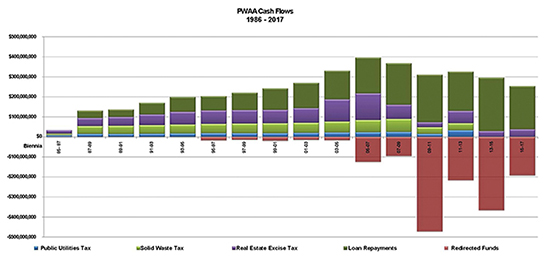|
Subscribe / Renew |
|
|
Contact Us |
|
| ► Subscribe to our Free Weekly Newsletter | |
| home | Welcome, sign in or click here to subscribe. | login |
Opinion
| |
March 22, 2017
Opinion: Washington state slashes infrastructure funds
Special to the Journal
Imagine your child came home from school with a report card covered in “C” grades. For most parents, this would be a wake-up call. Time for a heart-to-heart discussion, more focus on homework, maybe even investing in a tutor.
Unfortunately, when Washington state came home with an infrastructure report card covered in “C” grades, our state legislators took the opposite approach.
Using the “out of sight, out of mind” philosophy, they are planning to curtail Washington state's No. 1 source of low interest infrastructure funding.
Reducing this funding source will not only have a directly negative impact on Washington state's ability to address key drinking water, sewer and storm water infrastructure, it could not come at a worse time.
The American Society of Civil Engineers just released the 2017 Infrastructure Report Card. According to data from as far back as 2013, Washington state receives a “C” grade: We need an estimated $9.5 billion in drinking water infrastructure, and another $4 billion in wastewater/sewer infrastructure, over the next 20 years.
Established in 1985, the Public Works Assistance Account (PWAA) is the No. 1 source of affordable infrastructure funding for Washington state.
Over its 31-year history, PWAA has loaned $2.8 billion dollars to local cities and utility districts, for projects totaling $4.6 billion in Washington state construction. That resulted in the creation of more than 46,000 jobs. Not one of these low interest loans has ever defaulted.
PWAA is managed by governor-appointed members of the Public Works Board, in accordance with Revised Code of Washington (RCW) 43.155. From its initial seed money of $35 million, along with a small percentage of annual real estate excise tax, solid waste tax, and water and sewer tax, the self-sustaining fund provides extremely low interest financing to help small and large cities and utility districts proactively upgrade and replace infrastructure.
PWAA funding provides loans for six different types of infrastructure systems, including drinking water, sewer, stormwater, roads, bridges and solid waste. The majority of the loans are applied to drinking water and sewer infrastructure.
Why is drinking water and sewer infrastructure — a critical foundation for a safe and healthy society — so often overlooked?
Underground systems are invisible… and a lot easier to ignore. Cities would sooner include more visible transportation projects in their annual infrastructure planning — even though a water system technically “transports” water to and from our schools, residences and businesses.
What caused our legislators to make this decision, even though our state's infrastructure is still in crisis?
Two words: educational funding. At least that's what they're telling us.
For the past seven years, legislators have been diverting funds from the PWAA to balance the budget, relying on the “unseen and easily forgotten” factor of underground water and sewer infrastructure systems to remain ignored until an emergency.
James Kuntz is executive director of the Washington Association of Sewer and Water Districts.
Tell us what you think...
The Daily Journal of Commerce welcomes your comments.
- E-mail: editor@djc.com
Previous columns:
- Opinion: Waterfront Initiative 123 is a bad idea, 07-25-2016
- Opinion: Here are a few tweaks to Seattle's zoning that could open up some design options, 06-06-2016
- Editorial: Here's why I'll be wearing red on Friday, 02-04-2016
- Opinion: MBA students make a Tech Trek to the NW, 02-01-2016
- Opinion: How we can keep growth from triggering anti-growth backlash, 12-07-2015
- No signs of a housing bubble — for now, 06-25-2015
- Opinion -- Transportation 2040 plan: What's the return on $174B?, 05-26-2015
- Opinion: Local group says disposal of sewage sludge on farms, forests is a bad idea for public health, 10-07-2014



